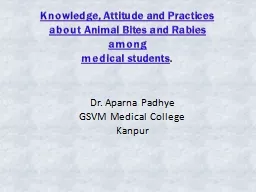

Practices about Animal Bites and Rabies among medical students Dr Aparna Padhye GSVM Medical College Kanpur Background Rabies is an acute highly fatal disease affecting the central nervous ID: 909584
Download Presentation The PPT/PDF document "Knowledge, Attitude and" is the property of its rightful owner. Permission is granted to download and print the materials on this web site for personal, non-commercial use only, and to display it on your personal computer provided you do not modify the materials and that you retain all copyright notices contained in the materials. By downloading content from our website, you accept the terms of this agreement.
Slide1
Knowledge,
Attitude and Practices about Animal Bites and Rabies among medical students.
Dr. Aparna Padhye
GSVM Medical College
Kanpur
Slide2Background Rabies is an acute highly fatal disease affecting the central nervous
system, ultimately causing disease in the brain and death. The early symptoms of rabies in people are similar to that of many other illnesses, including fever, headache, and general weakness or discomfort. As the disease progresses, more specific symptoms appear and may include insomnia, anxiety, confusion, paralysis, excitation, hallucinations, agitation, hypersalivation, difficulty swallowing, and hydrophobia. Death usually occurs within days of the onset of these symptoms.
Slide3It is a preventable viral disease of mammals, caused by Lyssavirus, most often transmitted through the bite of rabid animals such as dogs, cats and jackals.
Given the high case fatality rate, awareness regarding rabies is of prime importance.
Slide4ObjectivesTo assess the knowledge
regarding epidemiology, prevention and control of rabies among medical students in different years of medical education and training. To study the practices of medical students after dog bite.
Slide5Material and methodsA cross-sectional study was conducted among 817 MBBS students, from
first year to final year, of GSVM Medical College Kanpur.A pre-tested questionnaire was used.Data was analysed using Instat and chi square test for trend was applied.Results were interpreted at 5% level of significance.
Slide6Results
NO. OF STUDENTS IN THE STUDY (N=817)
Slide7Overall analysis showed:About 80% subjects knew that rabies is caused by a virus.100% knew dog bite as main source of transmission and only
60% knew about transmission by other animals. Hydrophobia as a symptom was known to all subjects(99.5%) but prodromal symptoms(34.2%), perspiration/excessive salivation(37%),muscle spasms(66.3%) and aerophobia(61%). It was comparatively less commonly known.Almost everyone knew that the disease is nearly always fatal(99%). After dog bite, 90.3% subjects got vaccinated whereas only 77% got immediate wound toilet done.
Slide8Knowledge regarding epidemiology of rabies among medical students
Slide9Knowledge about symptoms of Rabies
Slide10Knowledge about disease prevention and control among medical students
Contd.
Slide11Contd.
Slide12Practices following dog-bite in a sub-sample of the study population
Slide13Conclusions The study showed that the level of awareness of rabies and its control measures was higher among the 3rd
professional students as compared to those in 1st and 2nd professionals.An increasing trend in the knowledge was observed with increasing years of medical education. Yet the knowledge about wound toilet, vaccination schedule and doses and reporting to municipal authorities was significantly low.
Slide14Recommendations This suggests that overall knowledge about rabies is good.However, the students in the 1
st year, who are coming from the general population, have lesser awareness.This signifies that there should be efforts to increase the awareness about rabies through inculcating it in the curriculum of the students studying in high school and intermediate. This will help to spread the knowledge in the society which will in turn help to reduce morbidity and mortality of such a common yet serious disease.
Slide15THANK YOU